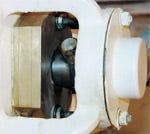Rotary Airlock Valve Increases Efficiency, Reduces Costs
May 26, 2009
|
Side front view of PAV-12 showing customer-applied accessories |
Specialty Minerals operates a small facility in Wisconsin Rapids, WI. The plant processes 100 tn/day of minus ¾-in. pebble lime for use as a filler and brightener by an adjacent paper mill. As part of the process, pebble lime is off-loaded from railcars, transferred into the plant, and stored in one of two silos. As needed, it is pneumatically transported from the silos to a slaking operation, which prepares the lime into slurry by mixing with water.
For years, the company used Ni-Hard valves with U-cup packing-type shaft seals to feed pebble lime from the silos into the pneumatic convey line. After three months of service, the 6 psi internal conveying line pressure would blow out the shaft seals, causing pebble lime to leak onto the ground. The spilled lime compromised the safety of plant personnel, and replacing seals required significant costs in labor and maintenance.
Specialty Minerals also experienced shortened life from the valves. Being abrasive in nature, the pebble lime would wear the sealing edges of the valve rotor and corresponding bore. As the clearances on the valve increased, excessive amounts of pneumatic air would leak upward through the valve and into the storage silo. The air disrupted mass flow of product into the valve, reducing its displacement and ultimately lowering production line capacity. In just 15 months, the company was forced to shut down the line and replace the valve.
Due to the limited time and resources available to combat these problems, Rick Kniprath, plant maintenance technician for the Wisconsin Rapids facility, contacted Prater-Sterling through its local representation, Matt Schaldach of MKS Processing & Packaging. Having successfully used Inpro bearing isolators in another area of the plant, Kniprath asked if Prater could supply a rotary airlock with the same type of seal. Schaldach relayed this information to Prater-Sterling, which agreed to build the valve as requested.
|
Patented Inpro Air Mizer cut away |
As a result, Prater supplied a Model PAV-12 HD rotary airlock valve with a 12-in. throat. The valve was a direct fit replacement for the valve previously used. All Prater valves come with standard outboardmounted, sealed-for-life bearings, and a fabricated, open-end rotor. Working closely with Kniprath to provide a specific engineered solution, the valve was custom designed with Inpro Air Mizer shaft seals designed to eliminate shaft seal leakage. A ceramic-lined housing with tungsten-coated rotor blades provides longer wear life against the abrasive pebble lime.
To properly apply the custom seals, Prater worked closely with Inpro to select and install the Air Mizer onto the valve. Like all Inpro products, the Air Mizer seal is comprised of a stator fixed in place on the valve’s end plate and a rotor pressed onto the valve’s shaft. When fitted within one another, the two parts form a noncontacting, nonwearing labyrinth. For further isolation, compressed air is purged into the stator, which, when combined with the labyrinth, forms a positive barrier to keep product inside the valve, even when opposed by a positive internal pressure within the valve. Fitting the stator to the end plates required custom modifications to remove the existing stuffing box where packing would normally be fitted. This was easily accomplished at Prater’s factory, where final valve assembly and checkout took place.
To combat wear, Prater lined the valve with its exclusive 1/8-in.-thick, alumina ceramic tiles. Unlike other spray-on ceramic coatings, Prater’s glued and vacuum-bonded ceramic tiles will not separate from the valve body under normal use. The alumina ceramic composition provides 20–40 times more hardness than conventional Ni-Hard castings.
|
Close-up of PAV-12 end plate showing Inpro Air Mizer air seal |
Furthermore, to ensure consistent tolerances and a positive air seal, all Prater ceramic-lined valves are diamond-honed to original dimensions. This added step ensures that these ceramic-lined valves come with the same 0.008-in. or less operating clearance offered on the company’s normal products. This minimal clearance limits air loss across the valve, resulting in improved mass flow from bins and higher displacements over the life of the valve.
Specialty Minerals purchased and installed the first PAV-12 valve in September 2006. Over the course of 15 months’ operation, no seal leaks were reported. In January 2008, it was removed for inspection, and found to be in good working order with no wear. A second valve has been operating in its place since then. Currently both silos operate the valves, with a third available as a spare.
Kniprath was asked about the impact of the improvements. He said each new valve has eliminated almost $2000 in annual costs attributed to lost production time, cleanup of wasted product, and parts and labor to change the seals. He also said that Specialty Minerals’ production line now runs more consistently and at higher capacity with no downtime. The valves are also conservatively estimated to last a minimum of three to five times longer, significantly reducing costs to replace or repair worn valves on a more frequent basis. Overall, each new valve is expected to save Specialty Minerals $9500 per year, providing payback in less than two years.
Prater-Sterling has been providing particle management solutions for more than 80 years. The company offers an extensive line of equipment and engineered systems including lump breakers, hammer mills, fine grinders and classifier mills, screeners and separators, air classifiers, compactors, minor- and micro-ingredient batching systems, and plantwide automation and controls. For more information, visit www.prater-sterling.com.
You May Also Like





